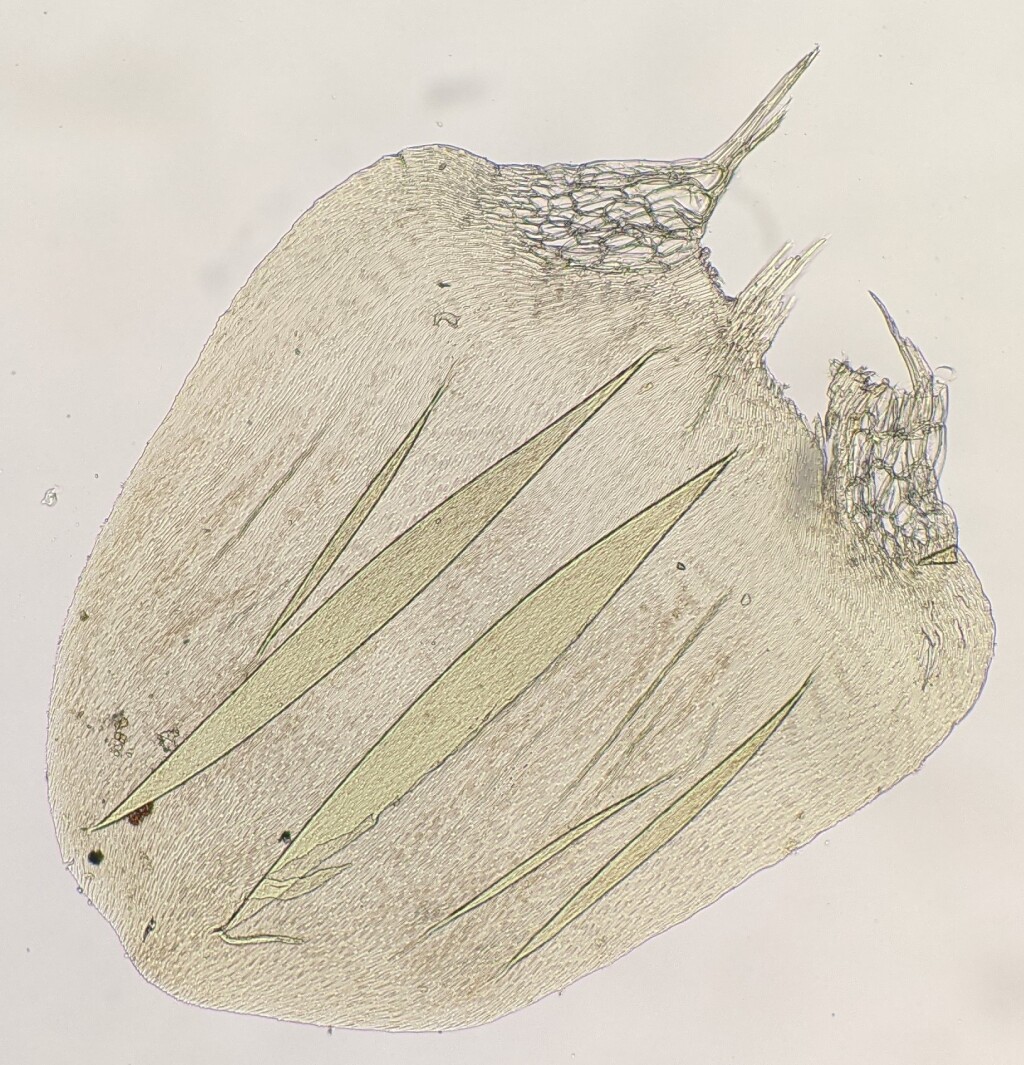Acrocladiaceae
Autoicous. Asexual propagules absent. Mats on trees, logs or soil. Stems creeping, irregularly branched from all around the stem, apices cuspidate, with rhizoids at bases of branches or occasionally longer rhizoids in sparse scattered bundles along stems and branches; paraphyllia absent; pseudoparaphyllia lacking around mature branches; central stand present, narrow. Leaves arranged around stem and facing all directions, monomorphic, spreading to erect, tightly imbricate, scarcely altered when dry, decurrent; apex obtuse to rounded, without a hairpoint; costa absent, single, sometimes extending up to midleaf, or short and double; margins entire, plane, without a border; laminal cells linear, smooth, shorter toward apex and slightly shorter and wider toward insertion; alar cells conspicuously and abruptly differentiated in ± rectangular decurrent patches, rectangular, hyaline, inflated. Pleurocarpous. Capsules inclined, curved, exserted, operculate, with a well differentiated annulus. Calyptra cucullate, smooth, glabrous. Operculum conic. Peristomes double and alternate; exostome of 16 entire and shouldered teeth; endostome of 16 well developed segments, with a high basal membrane; cilia present.
One genus, with one species in temperate Australia, New Zealand and nearby Subantarctic Islands and another in temperate South America, the Juan Fernández Islands and Marion Island.
Acrocladium has usually been placed in the past in either the Amblystegiaceae (e.g. Brotherus 1909; Crum 1991) or the Lembophyllaceae (e.g. Fleisher 1923; Goffinet & Buck 2004). Acrocladium has well demarcated alar regions composed of inflated cells like in many Amblystegiaceae and has cuspidate stem apices like Calliergonella Loeske, which was previously included in this family. Acrocladium also has tightly imbricate, strongly concave leaves like most Lembophyllaceae. Contrary to these morphological inferences, phylogenetic analyses of chloroplast and nuclear DNA sequences revealed Acrocladium to be most closely related to Lepyrodon, rather than being part of either Amblystegiaceae or Lembophyllaceae lineages (Quandt et al. 2009; Tangney et al. 2010). Acrocladium is now best recognised as its own family, given the many morphological dissimilarities between Acrocladium and Lepyrodon (Tangney et al. 2010). Placement of Acrocladium in a broadly circumscribed Plagiotheciaceae has also been proposed (Pedersen & Hedenäs 2002), however, a close relationship to Plagiotheciaceae, even with additional genera added to it, was not strongly supported in phylogenies based on molecular data or when this data was combined with morphological data.
 Spinning
SpinningBrotherus, V. F. (1909). Musci, in Engler, A. & Prantl, K. (eds), Die Natürlichen Pflanzenfamilien. Engelmann, Leipzig.
Crum, H. (1991). A partial clarification of the Lembophyllaceae. Journal of the Hattori Botanical Laboratory 69: 313–322.
Fleischer, M. (1923). Die Musci der Flora von Buitenzorg Vol. 4. E.J.Brill, Leiden.
Goffinet, B.; Buck, W. R. (2004). Systematics of the Bryophyta (Mosses): from Molecules to a Revised Classification. Monographs in Systematic Botany from the Missouri Botanical Garden 98: 205–239.
Klazenga, N. (2012). Australian Mosses Online. 25. Acrocladiaceae. http://www.anbg.gov.au/abrs/Mosses_Online/Acrocladiaceae.pdf.
Pedersen, N.; Hedenäs, L. (2002). Phylogeny of the Plagiotheciaceae based on molecular and morphological evidence. The Bryologist 105: 310–324.
Quandt, D.; Huttunen, S.; Tangney, R.; Stech, M. (2009). Back to the future? Molecules take us back to the 1925 classification of the Lembophyllaceae (Bryopsida). Systematic Botany 34(3): 443–454.
Tangney, R.S.; Huttunen, S.; Stech, M.; Quandt, D. (2010). A review of the systematic position of the pleurocarpous moss genus Acrocladium Mitten. Tropical Bryology 31: 164–170.

